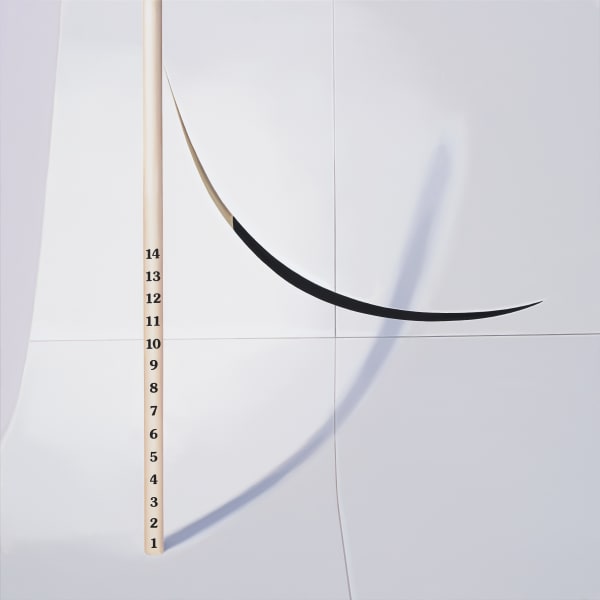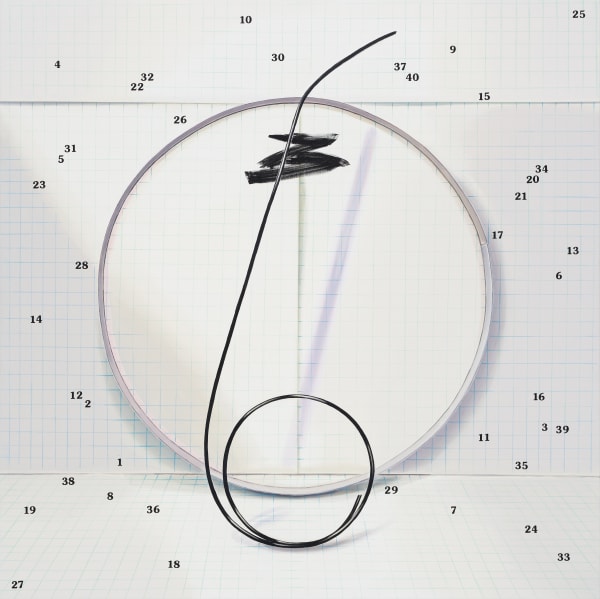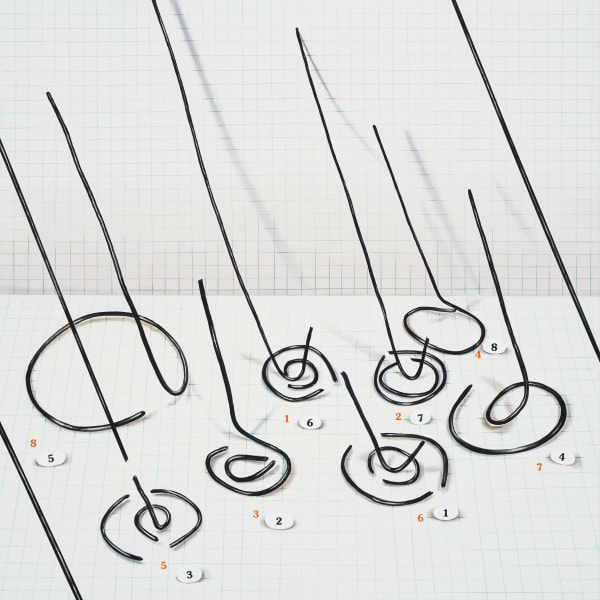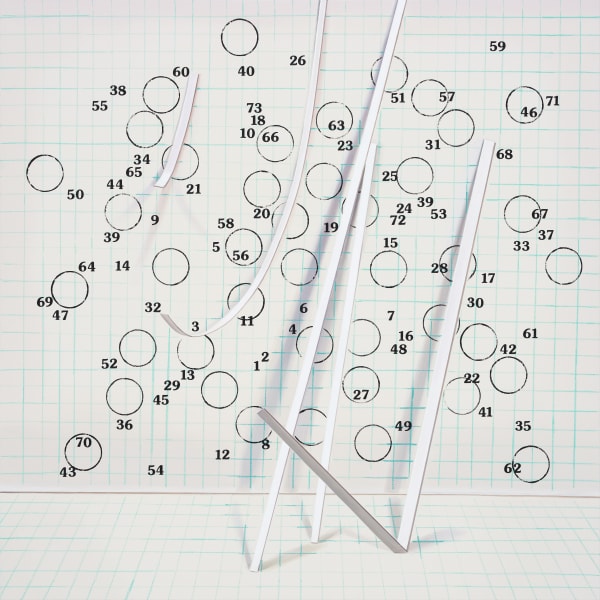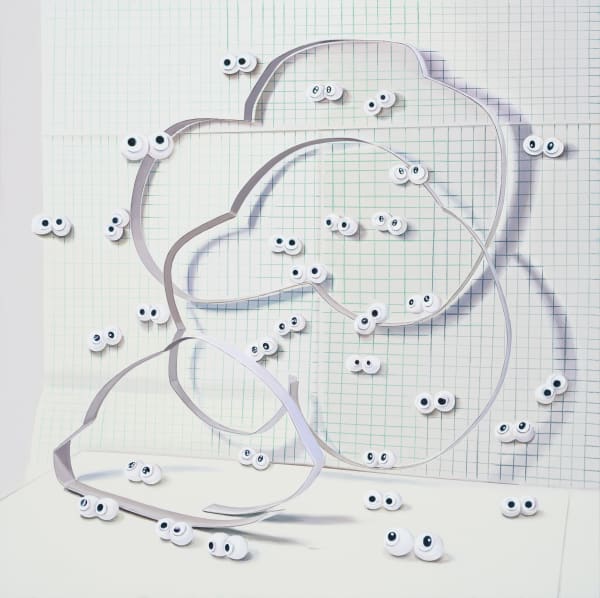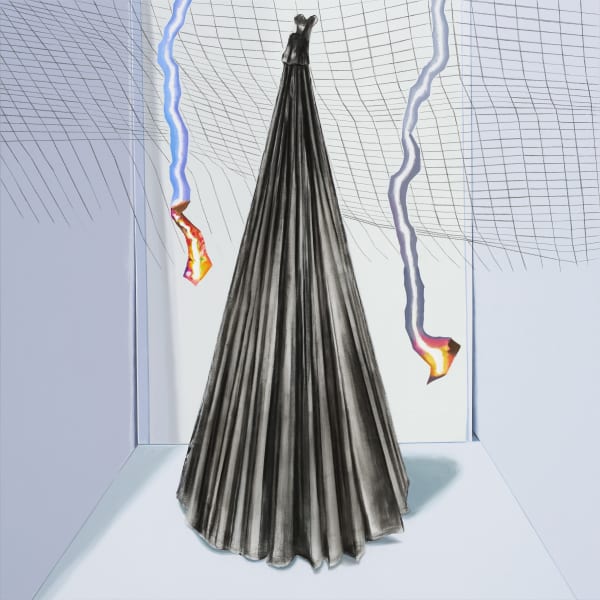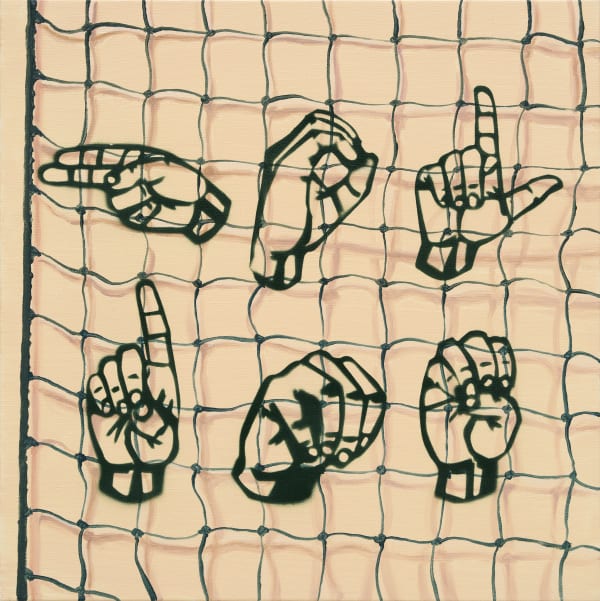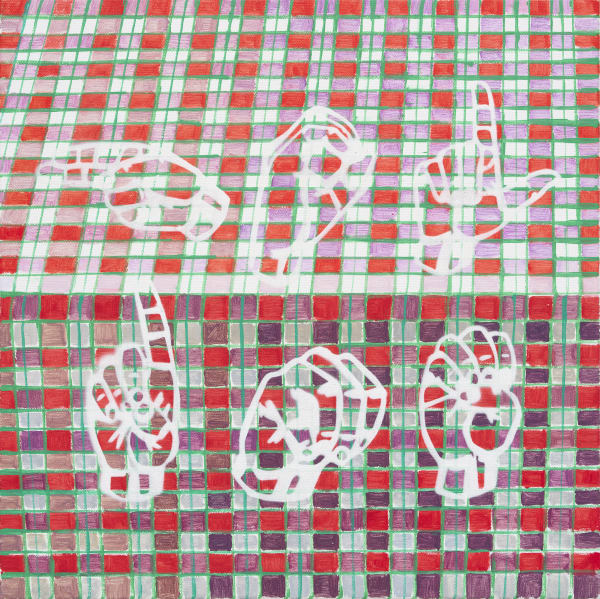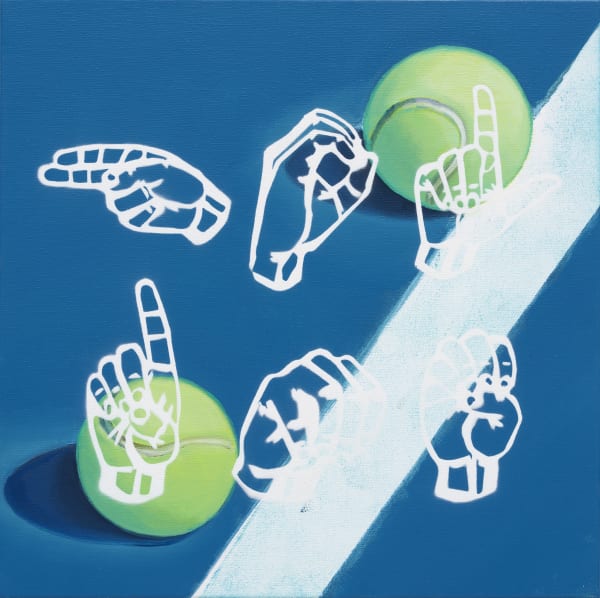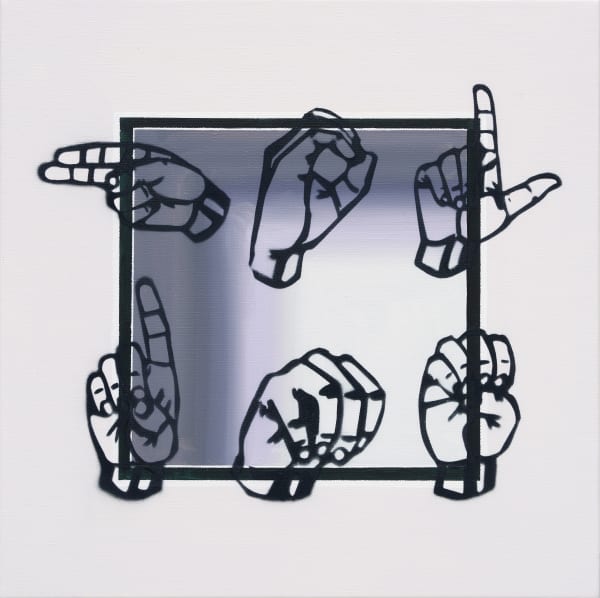HOLD ME: 김수연 Suyeon Kim
현실에서 잠시나마 벗어날 수 있는 순간은 하늘을 바라볼 때다. 그곳에는 우리가 해결해야 할 문제도 알아야 할 문제도 없다. 인간이 할 수 있는 것이 전혀 없는 하늘에 오로지 할 수 있는 단 한 가지는 그저 바라보는 것이다. 하지만 하늘은 멀리서 바라봐야만 하는 존재이기에 인간에게 궁금증을 불러일으키는 신비로운 공간이기도 하다. 오래전부터 육신은 죽어서 땅에 묻히지만, 그들의 영혼은 ‘하늘’로 올라간다고 믿었던 것을 보면 하늘의 텅 빈 공간이 인간에게 많은 사유를 불러일으켰음을 방증한다.
2020년은 김수연에게 많은 변화가 있던 시기였다. 그동안 분주하게 레지던시를 돌아다니며 작업을 해왔다. 주변을 돌아볼 여력이 없었다고 한다. 그러다 작년 서울에 작업실을 얻으면서 출퇴근하듯이 매일 정해진 시간에 같은 공간을 규칙적으로 이동하게 됐다. 동일한 장소를 지나갈 때 풍경의 변화를 만드는 것은 바로 날씨였다. 그리고 2020년에 있었던 50일간의 긴 장마 기간 동안 하늘에서 세차게 떨어지는 비를 하염없이 바라보았다.
김수연은 이번 전시에서 매일 마주한 날씨의 인상을 담아냈다. 하지만 자연은 시시각각 변화한다. 금방 사라져 버린다. 세상은 화가들에게 그들이 그리고자 하는 ‘무엇’을 던져주기는 하지만 그 세부를 어떻게 마무리 지어야 할지 가르쳐주지 않는 법이다. 그는 유독 눈에 띄는 날씨의 인상을 머릿속에 담아 두었다가 바로 그날에 그림이 될 장면을 묘사했다. 필요한 재료를 화방에서 사고, 오브제를 만들고, 그리드가 있는 공간 안에 날씨의 인상을 연출했다. 그리드는 비 혹은 눈이 내리던 공간의 좌표와 같다.
<Raindrops 5>는 하늘에서 떨어지는 비가 마치 검은색으로 보이던 날의 인상이다. 그림 안의 숫자는 빗방울이 떨어지던 순서와 바닥에 떨어져 만들어진 파동의 크기를 의미한다. <Raindrops 4>는 비의 시작을 알리는 첫 빗방울의 인상, <The Black Light After the Rainbow>는 무지개의 인상을 담아 냈다. <Sleet>는 진눈깨비가 빗방울로 변하는 순간과 비의 흔적을 보여준다. 그리고 실팔찌 디스크에 감긴 형형색색의 실처럼 보였던 빛의 인상이나 떨어지는 꽃잎을 통해 보여주는 바람의 인상 등을 표현했다.
날씨는 고정되지 않는다. 언제나 일시적이고 우연적이다. 김수연은 그런 순간적인 날씨의 인상을 그렸다. 아니 인상이라기보다는 주관적인 해석 혹은 상상에 가깝다. 작가가 그린 비, 눈, 구름, 무지개, 바람은 실제의 모습이 아닌 그 예기치 않은 형태 속에서 찾아낸 어떤 사물이다. 그의 그림은 날씨의 인상을 오브제에 투사한 그림이자 자연적인 것과 인위적인 것, 인상과 상상, 정확함과 부정확함, 채움과 비움, 자연에 대한 사유와 손의 노동이 만들어낸 그림이다.
김수연은 어느 날 종교인들이 열광하듯 ‘홀드 미(HOLD ME)’를 외치고 있으며, 자막으로는 ‘HOLD ME’라는 문구가 반복적 나왔던 해외 영상을 보게 됐다. 개인적으로 힘들었던 상황에서 그들이 외치던 ‘HOLD ME’는 마치 자신이 외치는 소리 혹은 자신에게 외치는 소리 같았다고 한다. <HOLD ME> 연작은 그 강렬했던 영상을 모티프로 시작한 작업이다. 작가가 평소 찍어둔 사진 중 자신의 눈을 ‘붙잡았던’ 풍경에 ‘HOLD ME’를 새겼다. 그는 문자 대신 알파벳을 형태의 근간으로 한 국제 수화를 활용했다. 수화가 몸이 만들어낸 하나의 제스처이면서 기호라는 점이 끌렸다고 한다.
전시 제목인 <HOLD ME>는 날씨 그림과 국제 수화로 표현된 모든 그림을 아우른다. 작가는 이번 개인전에서 어떤 식으로든 자신의 시선을 ‘붙잡았던 것’을 그림으로 보여준다. 하늘에서 내리던 비와 눈, 무지개, 바람, 번개와 같은 날씨에서부터 일상에서 우연히 마주친 사물은 느닷없이 우리의 시선을 끌어당기지만, 결코 붙들어 놓을 수 없는 풍경이다. ‘풍경’은 자신과 눈앞의 세계가 만날 때 탄생한다. 지금, 이 순간에 존재하는 자신과 자신이 대면한 세계를 인식하고 관찰할 때에만 가능하다. 그러니 풍경을 그린다는 것은 단순히 자연을 묘사한다는 것이 아니라 그것을 바라본 이의 내부에서 발동하는 이미지인 것이다. 대상의 몸과 표정을 읽고 형상을 부여하는 일은 오직 화가의 일이다. 김수연은 자신의 그림이 지극히 주관적인 해석의 결과라는 점을 내심 걱정했지만, 그는 그저 자신의 할 일을 했을 뿐이다.
Gazing at the sky, turning one's eyes to the heavens, is often a gesture of escape, even if only for that moment. In that elevated place, there are no burdensome worries nor are there issues that demand attention. Although humanity cannot grasp the sky or the heavens, it has been gazed upon through all our history as a subject of great curiosity and mystery. Perhaps it was this sense of the transcendent unknown attributed to the general direction of up that has bestowed upon humanity the belief of posthumous ascension.
The year 2020 was tumultuous for many artists, and for Suyeon Kim, it came as a catalyst for change. For years, she had been busy on the residency circuit, moving and creating, so engrossed that she had no margin to engage with what was happening around her life. Then last year she entered a residency in Seoul, and was able to commute regularly to the studio.When the commute became regular and the view outside the window also became routine, only the weather offered any variation to the scenery. When the pentecostal monsoon of 2020 washed over the streets of Seoul, Kim found herself gazing into the heavy curtains of rainfall.
In her latest solo exhibition, Suyeon Kim transposed her impression of the daily meteorological conditions during the monsoon season of 2020 on canvas. From one minute to the next, nature is whimsical; effervescent. Painters can be given inspiration or instructions on what to draw, but they are rarely given details, directions, or how to complete their work. Kim paid careful attention to the ambiance of the precipitous rainfall and transposed her impression unto canvas, on the day of painting. She purchased the necessary materials from the art supply store, created the objet and the impression of the weather within the grid space. The grid essentially plots the coordinates of rainfall or snowfall.
⟨Raindrops 5⟩ is an impression of rainfall one day when the droplets appeared particularly black. The numbers within represent the order of their downward arrival and the size of the splash created upon touching the surface of the ground. ⟨Raindrops 4⟩ is based on Kim's impression of the earliest droplets that herald rain, while ⟨The Black Light After the Rainbow⟩ is inspired by the prismatic effect of water droplets in the sky. ⟨Sleet⟩ captures the moment sleet turns into rain, and the traces left behind by rain. The artist conveys an impression of light expressed by colorful strings wrapped around the disc, the sense of wind presented as flower petals falling off.
Weather is never constant. It is constantly changing in arbitrary ways. Kim paints the ambiance of such transience: perhaps ambiance, perhaps arbitrary interpretation or imagination. The rain, snow, rainbow, and wind painted by her are not how they appeared originally, but what she found in unexpected forms. The paintings are impressions of weather conditions projected upon objects, and her thoughts and handiwork between nature and art, impression and imagination, accuracy and in accuracy, filling and emptying, and thoughts upon nature.
Kim encountered a foreign video of religious activities, where the faithful congregation shouted hold me with ardent zeal, the capitalized captions repeatedly flashing HOLD ME on screen. Struggling with her own burdens, during the year, the mantra-like hold me sounded like it was directed at her. The Hold Me series was sparked by that video motif, and she layered it as typography over a photo scenery that held her gaze. Instead of alphabetical text, she used International Sign Language to denote hold me, as the visceral gesture of sign language also caught her attention.
Hold Me includes all works created from a visualization of painted expressions of meteorological events with international Sign Language. Kim uses all creative means necessary to present things that at one time or other held her gaze. From the rain and snow precipitated from the sky, to rainbows, wind, lightnings, to encounters in the mundane, objects draw the gaze, but cannot hold it for long. Scenes are born in the tangent between the observing self and the occurring world. They are possible only through the existence of the self, perception of the outside world, and the observation of it. As such, painting scenes is not simply a representation of nature, but an outward expression of how it was perceived. Reading the physicality and impressions of a subject is truly exclusive to the artist's realm. Kim may have been burdened that her paintings might be subjectifications, but that is by definition the best one can do.
